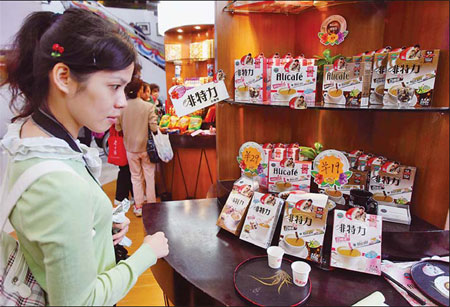Wake-up call for coffee lovers
 |
| A visitor to the Malaysia Pavilion mulls buying a bag of white coffee. |
 |
| A member of staff at the Indonesia Pavilion brews some kopi luwak for visitors. |
Round off your Expo trip with a civet cappuccino or an arabica espresso, Tang Zhihao reports.
Shanghai coffee lovers need to look no further than the Expo 2010 Shanghai to sample coffee from all around the world.
In the Expo Garden, visitors can find coffee from the world's most famous coffee-producing countries, including Ethiopia, Columbia and Indonesia.
At 380 yuan ($57.65) a cup, kopi luwak found on the third floor of the Indonesia Pavilion might be the most expensive coffee in the Expo Garden.
Kopi luwak, or civet coffee, is made from beans that have passed through the digestive tract of the Asian Palm Civet, a cat-sized mammal that lives in Indonesia and other Southeast Asian countries.
Kopi luwak is a rare coffee, and there are only about 225 kilograms produced every year. Four ounces will cost about $168, and it used to be recognized as the most expensive coffee in the world.
"It is the first time that kopi luwak has been sold in the Chinese market," said Mavis Mak, senior marketing communications and public relations manager of the Indonesia Pavilion. "When you drink authentic kopi luwak, you can feel something like coffee grounds in your mouth. You will not have that experience with any other coffee."
There are only 12 cups of coffee available daily. For those who are interested in trying kopi luwak, the Indonesia Pavilion should be the first stop in the Expo Garden.
For those looking for enjoying a warm cup of kopi luwak at home, there's a gift pack that contains five bags, a Siphon coffee maker, two cups and coffee cane that only costs 998 yuan - a much cheaper option than the cup of coffee available at the pavilion.
Just two minutes away from the Indonesia Pavilion, visitors will find white coffee from Malaysia. The coffee is not actually white, but gets its name from the way the coffee bean is roasted.
For a little less exotic and cheaper coffee, the Africa Joint Pavilion might be a good choice. Visitors will not only get 43 stamps on their Expo Passport but will also have the chance to try coffee from Ethiopia, a country ranked as the fourth-largest green coffee producer in the world in 2007.
At the corner of the Ethiopia Pavilion, visitors will be able to try authentic Ethiopian coffee prepared by people from Ethiopia for less than 30 yuan a cup.
"The coffee grown in Ethiopia is excellent in its natural quality because the beans are all natural and free from chemical fertilizers," said Endale Asfaw, who is a coffee producer from Ethiopia with 16 years of experience in the coffee industry. "Some roasters blend a small quantity of Ethiopian coffee into lower-quality coffee beans to upgrade their products."
Visitors may opt for black coffee at 15 yuan a cup, or coffee with milk for 20 yuan. Visitors can even take home some Ethiopian coffee, found at the Africa Joint Pavilion market.
And you can't talk about coffee without mentioning Columbia. Just a 10-minute walk from the Africa Joint Pavilion, visitors will find Columbian coffee.
As the world's largest producer of mild washed Arabica coffee, Columbia coffee's quality is guaranteed by having a certification mark and a denomination of origin attached.
"The coffee supplied in the Expo Garden is the best coffee produced in Columbia," said Andrs Valencia, a representative of the National Federation of Coffee Growers of Colombia for Asia.
With all the coffee available in the Expo Garden, a stroll around some of the pavilions will soothe the cravings of even the jitteriest Expo visitor.
 0
0 







Go to Forum >>0 Comments